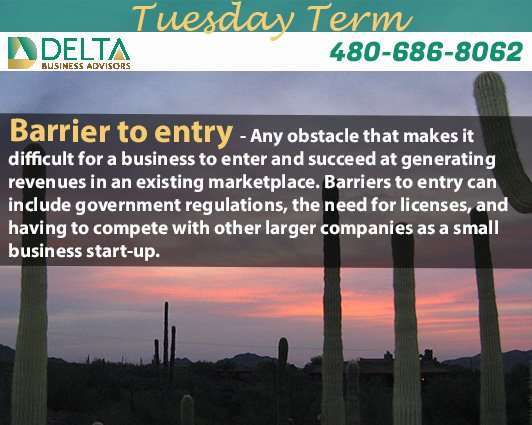Any obstacle that makes it difficult for a business to enter and succeed at generating revenues in an existing marketplace. Barriers to entry can include government regulations, the need for licenses, and having to compete with other larger companies as a small business start-up.
Types of Barriers to Entry
There are two types of barriers:
1. Natural (Structural) Barriers to Entry
Economies of scale: If a market has significant economies of scale that have already been exploited by the existing firms to a large extent, new entrants are deterred.
Network effect: This refers to the effect that multiple users have on the value of a product or service to other users. If a strong network already exists, it might limit the chances of new entrants to gain a sufficient number of users.
High research and development costs: When firms spend huge amounts on research and development, it is often a signal to the new entrants that they have large financial reserves. In order to compete, new entrants would also have to match or exceed this level of spending.
High set-up costs: Many of these costs are sunk costs that cannot be recovered when a firm leaves a market, such as advertising and marketing costs and other fixed costs.
Ownership of key resources or raw material: Having control over scarce resources, which other firms could have used, creates a very strong barrier to entry.
2. Artificial (Strategic) Barriers to Entry
Predatory pricing, as well as an acquisition: A firm may deliberately lower prices to force rivals out of the market. Also, firms might take over a potential rival by purchasing sufficient shares to gain a controlling interest.
Limit pricing: When existing firms set a low price and a high output so that potential entrants cannot make a profit at that price.
Advertising: These are sunk costs. The higher the amount spent by incumbent firms, the greater the deterrent to new entrants.
Brand: A strong brand value creates loyalty of customers and, hence, discourages new firms.
Contracts, patents, and licenses: It becomes difficult for new firms to enter the market when the existing firms own licenses, patents, or exclusivity contracts.
Loyalty schemes: Special schemes and services help oligopolists retain customer loyalty and discourage new entrants who wish to gain market share.
Switching costs: These are the costs incurred by a customer when trying to switch suppliers. It involves the cost of purchasing or installing new equipment, loss of service during the period of change, the efforts involved in searching for a new supplier or learning a new system. These are exploited by suppliers to a large extent in order to discourage potential entrants.
https://corporatefinanceinstitute.com/resources/knowledge/economics/barriers-to-entry/
